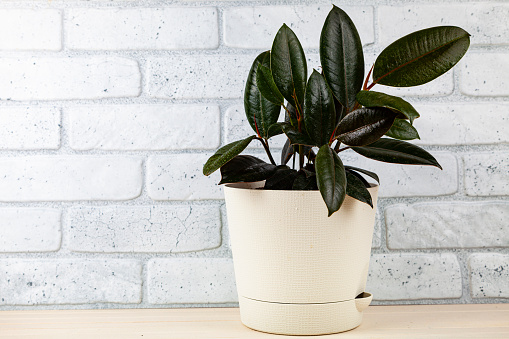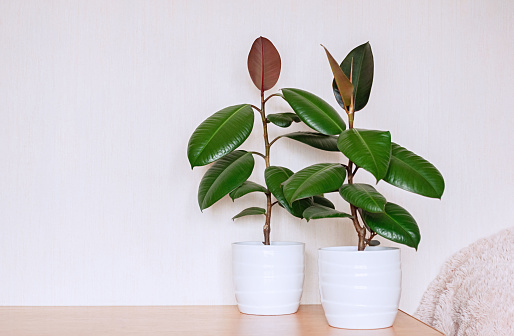Rubber Plant Watering (How Much and How Often to Water)
Hey folks! What about growing a Rubber plant in your home? It will add a great look to your area which makes them attractive. The rubber plant (Ficus elastica) is a popular houseplant that is known for its large, glossy leaves. Native to Southeast Asia, the rubber plant can grow up to 50 feet tall in its natural habitat. While it is typically a tropical plant, the rubber plant can also be grown as a houseplant in most temperate climates.
What troubles a farmer is the supply of water to the rubber plant. Do you know the schedule for rubber plant watering? Do you know How Much and How Often to Water? If yes, then you are going great and if not, then you need to know about this.
Rubber plants like to thrive well in moist soil but make sure the soil is not waterlogged. Before watering the plant, you need to check if the plant needs water or not, It can be checked by inserting a finger in the soil about an inch down and if it feels dry, then is time to water the rubber plant.
If you are thinking about adding a rubber plant to your indoor jungle, here are some tips on how much and how often to water your rubber plant. So, what are you waiting for? Let’s get started to know about the schedule of Rubber Plant Watering.

Rubber Plant Watering (How much to Water the Rubber Tree Plant?)
It is crucial to water your rubber tree plant regularly, as it will help to keep the plant healthy and prevent it from drying out. However, you should be aware of how much water your plant needs and how often to water the rubber plant. Set your schedule for regular Rubber Plant Watering so that the plant thrives well.
The amount of water that your rubber tree plant needs will depend on a number of factors, such as the size of the plant, the type of soil it is grown in, and the climate. In general, most rubber tree plants need to be watered every 7-10 days. However, if you live in a hot or dry climate, you may need to water your plant more frequently.
When watering your rubber tree plant, be sure to check the soil before adding water. The soil should be moist but not soggy. If the soil is too dry, add enough water so that it is evenly moistened. If the soil is too wet, allow it to drain before adding more water.
You have to make sure while giving water to your plants that it has a good amount of drainage holes to thrive well. It will not collect the water and let the plant breathe properly. Do not make use of any saucer for your plant. Remember you are not letting your plant suffer from the sogginess. So, I hope you are clear with the Rubber Plant Watering.
How often to water the rubber plant?
Do you know how often to water the rubber plant? if yes, then great but if not, then you need to know about Rubber Plant Watering as it keeps the plant healthy. In general, rubber plants should be watered about once a week. However, this can vary depending on the plant’s size, potting mix, and the temperature and humidity of your home.
If you’re unsure how often to water the rubber plant, start by checking the soil every few days. If it feels dry to the touch, it’s time to water.
When watering, always soak the soil until it is evenly moistened. Allow the excess water to drain away before putting the plant back in its pot.
If you notice that your rubber plant is drooping or its leaves are wilting, this is a sign that it needs more water. Increase Rubber plant watering accordingly until the plant recovers.

Things to consider at the time of Rubber Plant Watering
Some of the things that need to be followed when it comes to Rubber Plant Watering. They are as follows:
Type of pot
When it comes to Rubber Plant Watering, the type of pot you have will play a big role in how often to water the rubber plant. If you have a plastic pot, for example, you will need to water it more frequently than if you have a clay pot. The reason for this is that plastic pots tend to dry out quickly, while clay pots help to retain moisture.
If you’re not sure what type of pot you have, take a look at the bottom of the pot and see if there are any drainage holes. If there are no drainage holes, then it’s likely a plastic pot. If there are drainage holes, it could be either a plastic or clay pot.
In general, you should water the rubber plant every 7-10 days. However, if you live in an area with high humidity, you may only need to water every 10-14 days. And if you live in an area with low humidity, you may need to water every 5-7 days.
If your rubber plant is in a plastic pot, be sure to check the soil before watering. If the soil is dry to the touch, it’s time to water. If the soil is still moist, wait another day or two before watering again.
If your rubber plant is in a clay pot, be sure to check the moisture level of the soil before watering. The best way to do this is to stick your finger into the soil up to the first knuckle.
Related: Why do Rubber Tree Leaves curl?
Dryness of soil
As with any plant, it’s important to know the schedule of Rubber Plant Watering. Too much water and your plant will start to drop leaves. Not enough water and your leaves will begin to turn brown and drop off. The key to rubber plant watering is to keep the soil moist but not soggy.
The best way to water a rubber tree is to use lukewarm water and soak the roots thoroughly. Allow the water to drain completely before putting the plant back in its pot. If you’re unsure whether or not your plant needs water, stick your finger into the soil up to the first knuckle. If the soil feels dry, it’s time to water.
Checking soil from drainage holes
If you’re wondering whether you need to do the Rubber Plant Watering, checking the soil is a good place to start. The soil around the drainage holes of your pot should be moist, but not soggy.
To check, stick your finger about an inch into the soil. If it feels dry, it’s time to water. This will let you know if you have to do Rubber Plant Watering or not.

Signs of leaves wilting
When it comes to watering your rubber plant, the leaves are one of the best indicators of whether or not the plant is getting enough water. Another thing to keep in mind while Rubber Plant Watering is to observe the signs of leaves wilting.
If the leaves are wilting, it’s a sign that the plant needs more water. There are a few other signs to look for that can indicate that your rubber plant needs more water, including:
-The leaves are drooping
-The leaves are yellowing
-The leaves are browning
-There is new growth that is wilting
If you see any of these signs, it’s important to increase the frequency of watering for your rubber plant.
Wrapping up the Context
In this guide, you come to know that The rubber plant (Ficus elastica) is a popular houseplant that is known for its large, glossy leaves. Native to Southeast Asia, the rubber plant can grow up to 50 feet tall in its natural habitat. While it is typically a tropical plant, the rubber plant can also be grown as a houseplant in most temperate climates. Rubber plants like to thrive well in moist soil but make sure the soil is not waterlogged. Before watering the plant, you need to check if the plant needs water or not, It can be checked by inserting a finger in the soil. Read the full guide for its proper understanding.
Thanks for reading! Happy gardening!
FAQ’s
How do rubber plants like to be watered?
Water your rubber plant with care. These plants like to be kept moist, but not wet. Allow the top inch of soil to dry out between watering. Water deeply and thoroughly, until water runs out of the drainage holes at the bottom of the pot. Reduce watering in the winter, when growth slows.
These plants are native to tropical areas and prefer humid conditions. If the air in your home is too dry, increase humidity by setting the plant on a pebble tray or grouping it with other plants.
How do I know if my rubber tree needs water?
If you’re wondering how often to water rubber plants, the answer is: it depends. The frequency of watering will vary depending on the size and type of plant, the potting mix, the temperature and humidity, and whether the plant is in a sunny or shady spot.
Here are a few general tips for watering rubber plants:
– Water when the top inch or so of soil is dry to the touch.
– If possible, use filtered or distilled water to avoid any build-up of minerals in the soil.
– Allow the water to drain away freely from the pot after watering.
– If your plant is looking wilted or droopy, it’s probably thirsty and needs a drink!
How do you know if a rubber plant is over or under-watered?
If you’re not sure whether you’ve watered your rubber plant too much or too little, there are a few telltale signs to look for. If the leaves are drooping and/or the soil is dry several inches below the surface, your plant is probably thirsty and in need of a good drink.
On the other hand, if the leaves are wilting and the soil is soggy, your plant has had too much water and needs to dry out a bit.
Should I Bottom water my rubber tree?
As with any plant, rubber trees need the right amount of water to stay healthy. Too much or too little water can cause problems.
If you’re unsure whether your rubber tree needs watering, it’s best to err on caution and bottom water. Bottom watering means adding water to the tray or saucer under the pot so that the roots can soak up moisture from the bottom up.
This method is especially helpful in preventing root rot, which can occur if the roots sit in water for too long. It’s also a good way to water if your plant is looking wilted or droopy.
To bottom water your rubber tree, simply add enough water to the tray or saucer to moisten the soil without making it soggy. Allow the tree to soak up the water for a few hours, then empty out any excess.


